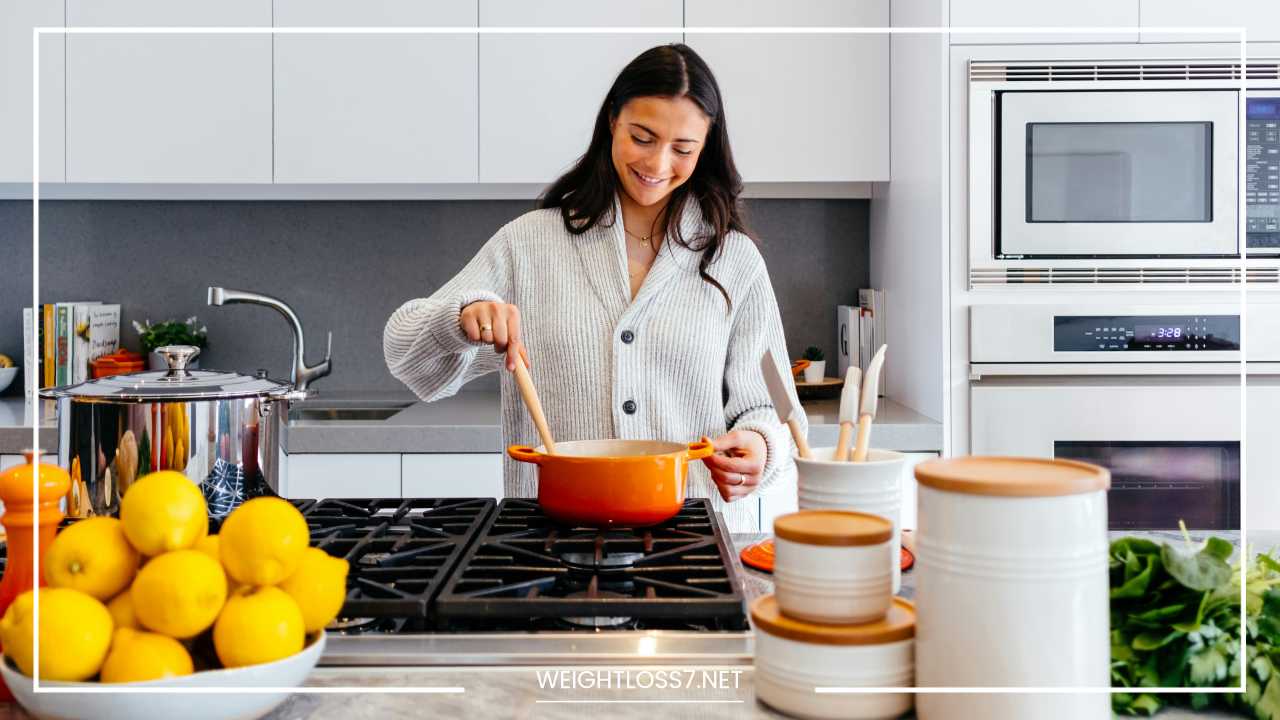How to Reduce Fat and Calories When You Cook

Calorie Reduction
How to Reduce Fat and Calories When You Cook: Deliciously Healthy Meals Made Easy
Cooking at home is a superpower waiting to be unleashed. It empowers you to take control of your health and well-being, crafting meals that are both flavorful and fuel your body. But sometimes, even the most well-intentioned home-cooked dishes can harbor hidden reserves of fat and calories.
Worry not, culinary adventurer! This comprehensive guide equips you with a treasure trove of tips and tricks to transform your kitchen into a haven for healthy, flavorful creations.
We’ll delve into smart ingredient swaps, explore alternative cooking methods that unlock hidden health benefits, and unveil secrets to maximizing taste without sacrificing your health goals.
Smart Swaps for Savvy Cooks: Beyond the Basics
The foundation of reducing fat and calories lies in making strategic substitutions in your recipes. Let’s go beyond the basic swaps and explore some clever culinary alchemy that won’t compromise on taste:
-
Protein Powerhouses: While lean protein is key, explore different textures. Opt for ground chicken or turkey for a lighter take on burgers or meatballs. Embrace the versatility of tofu! Scramble it for a vegan breakfast option, marinate and bake it for a protein-packed centerpiece, or add it to stir-fries for a satisfying meat substitute.
-
Fat Trimming Techniques: Go beyond simply trimming visible fat. Score fatty meats like pork tenderloin to allow heat to penetrate, promoting even cooking and rendering excess fat. For chicken breasts, consider pounding them thin to create a uniform thickness, which cooks quickly and reduces overall cooking time, minimizing fat loss from the meat itself.
-
Dairy Delights: Beyond low-fat or fat-free options, explore the world of plant-based alternatives. Soy milk, almond milk, and even cashew milk can be used in smoothies, baking, and even savory sauces. Experiment with different varieties to discover your favorites.
-
Oil Alternatives: When a recipe calls for oil, not only can you use a light touch, but explore flavorful alternatives. Sesame oil, infused olive oils (like garlic or chili pepper), or even a touch of nut butter can add a unique dimension of flavor without a significant calorie increase. Consider using non-stick cooking sprays, but remember, even these can add up. Opt for a mister filled with broth or water to coat your pans for a virtually fat-free option.
-
Carb Conscious Choices: Think beyond just swapping refined carbs for whole-wheat alternatives. Explore options like cauliflower gnocchi, zucchini noodles (zoodles), or even spaghetti squash for a delicious low-carb twist on classic pasta dishes. For rice alternatives, experiment with quinoa, brown rice blends, or even chopped cauliflower for a satisfyingly textured addition to your meals.
Cooking Methods for Healthier Eats: Mastering the Art of Heat
The way you cook your food significantly impacts its health profile. Let’s explore some cooking methods in detail, along with tips to maximize their fat- and calorie-reducing benefits:
-
Grilling and Broiling: These methods allow excess fat to drip away from the food, resulting in a healthier and more flavorful dish. Marinate your meats beforehand to infuse them with flavor and prevent dryness. Use a grill pan indoors if you don’t have access to an outdoor grill. Opt for lean cuts of meat, fish, or even vegetables like asparagus, bell peppers, and zucchini for a vibrant and healthy grilled platter.
-
Baking and Roasting: These methods use minimal oil and rely on the natural moisture of the food to cook it through. For even more flavor, use a technique called “dry brining.” This involves rubbing the food with salt and spices a day before cooking. The salt draws out moisture, which is then reabsorbed along with the flavors, resulting in a more flavorful and juicy dish.
-
Air Frying: This popular appliance uses minimal oil to circulate hot air, creating a crispy exterior and juicy interior. It’s a great alternative to deep-frying, but remember, moderation is key. Explore air-frying vegetables like Brussels sprouts or cauliflower for a healthy and satisfying snack, or try air-frying tofu for a crispy and protein-packed addition to your meals.
-
Poaching and Steaming: These gentle cooking methods preserve nutrients and add minimal fat. They’re ideal for delicate proteins like fish and vegetables. Poaching is particularly suitable for chicken breasts, resulting in incredibly moist and flavorful cooked chicken. Steaming is a great way to cook vegetables while retaining their vibrant colors and textures.
-
Sautéing: While this method involves some oil, use a light touch and choose a non-stick pan to minimize the amount needed. Focus on high heat and quick cooking to prevent food from sticking and releasing excess moisture. This method is perfect for creating flavorful stir-fries or sautéing vegetables to accompany your main course.
Flavor Boosters for Calorie Cutters: Unleashing the Magic of Taste
Just because you’re reducing fat and calories doesn’t mean your food has to be bland! Here’s a deeper dive into how to add big flavor to your healthy dishes:
-
Herbs and Spices: Explore the vast and vibrant world of herbs and spices! They add depth and complexity without any added calories. Fresh herbs like basil, cilantro, and parsley add a burst of life to dishes near the end of cooking. Dried herbs and spices like cumin, turmeric, and smoked paprika offer a vast flavor palette to experiment with. Create your signature spice blends or explore pre-made blends designed for specific cuisines.
-
Citrus Zest: The zest of lemons, oranges, limes, and grapefruits adds a burst of brightness and freshness to your dishes. Zest brightens flavors in savory dishes like fish, chicken, and roasted vegetables. In sweet dishes, it complements desserts, fruit salads, and yogurt parfaits. Use a microplane grater or the fine side of a box grater to remove just the zest, avoiding the bitter white pith underneath.
-
Acidity: A squeeze of lemon juice or a splash of vinegar can brighten flavors and add a touch of tang. Citrus juices work well in marinades, salad dressings, and sauces. Vinegars like balsamic, red wine, or rice vinegar add depth and complexity to savory dishes. Experiment with different vinegars to discover your favorites.
-
Garlic and Onions: These aromatics are the foundation of many delicious dishes. They add savory depth without adding significant calories. Sauté chopped onions and garlic in a little olive oil or broth to create a flavorful base for soups, stews, sauces, and stir-fries.
-
Broths: Low-sodium vegetable or chicken broth can be used to add moisture and flavor to soups, stews, and sauces. Broth can also be used to deglaze pans after cooking meat, creating flavorful pan sauces with minimal added fat. Experiment with different broths to add depth to your dishes. Consider making your own broth for maximum flavor and control over sodium content.
Beyond the Plate: Strategies for Portion Control
Even the healthiest meals can become calorie bombs if you overindulge. Here are some tips for practicing healthy portion control that go beyond simply using smaller plates:
-
Mindful Eating: Slow down and savor your food! Pay attention to your body’s hunger cues. Eat slowly and stop eating when you’re comfortably satisfied, not stuffed. Put down your fork and take a breath between bites to allow your body to register fullness signals.
-
Plan Your Meals: Planning your meals ahead of time can help you avoid unhealthy choices when hunger strikes. Plan portion sizes in advance and stick to them. Prepping vegetables and protein in advance can also help you stay on track during busy weeks.
-
Snack Smart: Snacking can be a healthy way to stay energized throughout the day, but be mindful of your choices. Opt for fruits, vegetables with hummus, or a handful of nuts for nutritious and satisfying snacks.
-
Leftovers are your Best Friend: Cooking larger batches allows you to portion out leftovers for future meals. This can save you time and prevent unhealthy last-minute decisions. Repurpose leftovers into creative new dishes to avoid boredom.
Recipe Revamps for Guilt-Free Indulgence: Putting it into Practice
Now, let’s put theory into practice! Here are some classic recipe revamps to show you how to reduce fat and calories without sacrificing taste:
-
Creamy Tomato Pasta: Instead of heavy cream, use low-fat Greek yogurt or ricotta cheese thinned with low-sodium vegetable broth. Add a sprinkle of grated Parmesan cheese for a touch of richness without the added fat.
-
Creamy Chicken Noodle Soup: Ditch the cream! Instead, roast the chicken breasts or thighs for added flavor. Shred the cooked chicken and add it to a pot of low-sodium chicken broth along with chopped vegetables like carrots, celery, and onions. To thicken the soup slightly, mash some of the cooked vegetables or add a cornstarch slurry.
-
Mac and Cheese: This comfort food classic can be made healthier. Use whole-wheat pasta shells and a combination of low-fat cheddar cheese and cottage cheese for a creamy and satisfying sauce.
-
Meatloaf: Lighten up this classic by using lean ground turkey or chicken instead of beef. Add chopped vegetables like onions, peppers, and mushrooms for extra flavor and moisture. Bake the meatloaf instead of frying it for a healthier option.
-
Chicken Parmesan: This dish can be healthier with a few tweaks. Use boneless, skinless chicken breasts and coat them in a light layer of whole-wheat breadcrumbs. Bake or air-fry the chicken instead of frying it. Top with a lightened marinara sauce made with crushed tomatoes, fresh herbs, and a touch of red wine vinegar. Finish the dish with a sprinkle of reduced-fat mozzarella cheese for a satisfying and healthy twist on a classic.
-
Fresh Herbs vs. Dried Herbs: While both fresh and dried herbs offer flavor benefits, fresh herbs tend to have a brighter, more vibrant taste. Use them towards the end of cooking to preserve their delicate nature. Dried herbs are more concentrated in flavor, so you’ll need less. Experiment with different forms to find your preference.
-
The Magic of Misono Paste: This fermented soybean paste adds a savory depth of umami flavor to dishes. Use a small amount in marinades, dressings, or stir-fries for a flavor boost without added sodium.
-
Smoke Infusion: For a touch of smoky flavor without the added fat of grilling, consider smoked paprika or even a sprinkle of liquid smoke (use sparingly!). Smoked paprika adds a subtle smokiness, while liquid smoke offers a more intense flavor. Experiment in small amounts to avoid overpowering your dish.
-
Roasted Vegetables: Roasting vegetables brings out their natural sweetness and intensifies their flavors. Toss vegetables with a little olive oil, salt, pepper, and your favorite herbs before roasting. Experiment with different temperatures and roasting times to achieve the desired texture. Roasted vegetables are a delicious and versatile side dish or can be incorporated into salads, wraps, and bowls.
-
Fresh Chilis: For those who enjoy a bit of heat, fresh chilies like jalapenos, serranos, or habaneros add a kick of spice and a touch of brightness to your dishes. Start with a small amount, removing the seeds and white membrane for milder heat, and adjust according to your preference.
Beyond the Plate: Strategies for Portion Control:
-
Use Measuring Cups and Spoons: While not always necessary, using measuring cups and spoons for a few key ingredients, especially calorie-dense ones like oils and nut butters, can help you stay on track with portion control.
-
Downsize Your Dinnerware: While using smaller plates can create the illusion of a larger portion, consider using bowls for certain meals as well. Soups and salads naturally fill a bowl, promoting satiety with a smaller overall portion.
-
Get Active: Exercise plays a crucial role in weight management and overall health. Aim for at least 30 minutes of moderate-intensity exercise most days of the week. Combining healthy eating with physical activity creates a sustainable approach to weight management.
Recipe Revamps for Guilt-Free Indulgence:
-
Chicken Parmesan (continued): Top with a lightened marinara sauce made with crushed tomatoes, fresh herbs, and a touch of red wine vinegar. Finish the dish with a sprinkle of reduced-fat mozzarella cheese for a satisfying and healthy twist on a classic.
-
Shepherd’s Pie: This hearty dish can be made lighter by using lean ground lamb or a combination of ground lamb and lentils. Mashed cauliflower makes a delicious and lower-carb substitute for mashed potatoes. Top with a sprinkle of grated Parmesan cheese for a touch of richness.
-
Beef Tacos: Swap out the ground beef for lean ground turkey or shredded chicken. Use whole-wheat tortillas for a fiber boost and top with a variety of healthy and flavorful options like low-fat Greek yogurt instead of sour cream, salsa, chopped avocado, and a sprinkle of low-fat cheese.
-
Lasagna: This classic Italian dish can be lightened up by using whole-wheat lasagna noodles and a ricotta cheese and spinach filling. Reduce the amount of cheese overall and layer thinly sliced zucchini between the noodles for added moisture and a hidden dose of vegetables.
Remember: Cooking healthy meals doesn’t have to be complicated or restrictive. With a few simple swaps, alternative cooking methods, and a focus on flavor, you can create delicious and nutritious dishes that support your health goals. So, unleash your inner culinary adventurer and explore the world of healthy and flavorful cooking!

















